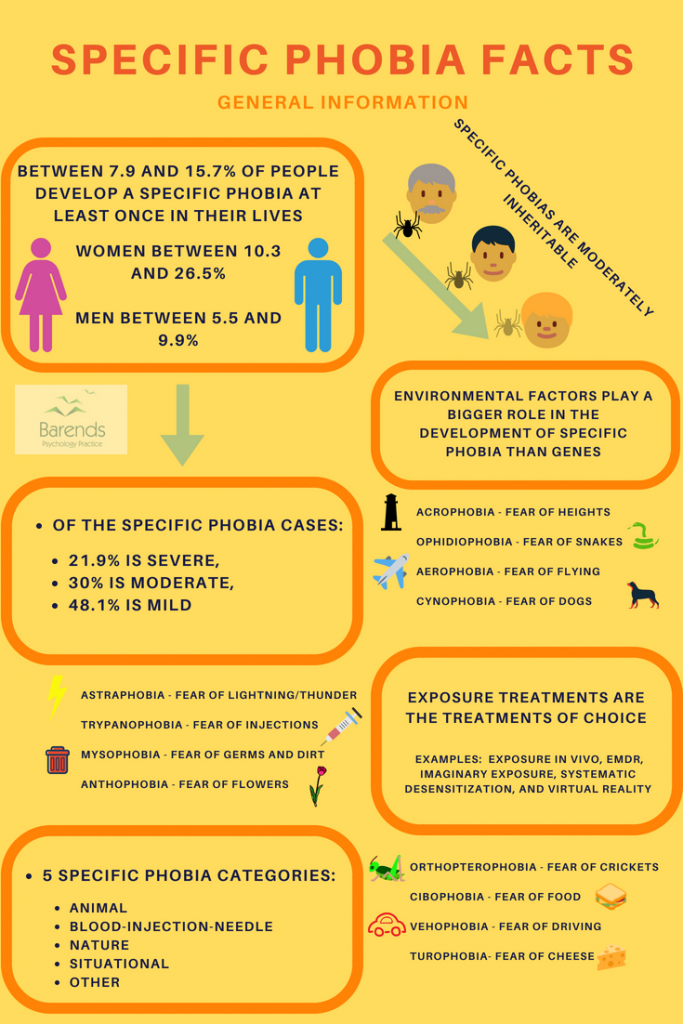Specific phobia facts
[responsivevoice voice=”US English Female” buttontext=”Listen to this section”]
Specific phobia is one of the most common mental disorders and has a very early age of onset [1],[4],[5],[6],[7]. Also, specific phobias often lead to the development of other mental disorders, such as panic disorder, generalized anxiety disorder, and obsessive-compulsive disorder [7]. The just mentioned interesting specific phobia facts are difficult to find online. Most interesting specific phobia facts can be found in scientific journals and are difficult and boring to read. Therefore, we’ve created this easy to read page with interesting specific phobia facts.
People who suffer specific phobias have irrational, continuing fears of a specific situation or object that is out of proportion to the actual risk. Because of these fears, they avoid getting in touch with the phobic situation or object. In severe cases, talking about it or seeing a picture of it can be enough to trigger the fear. In other words: if someone suffers from arachnophobia (fear of spiders) then that person will avoid direct contact with spiders. In some cases, even a picture of a spider or talking about a spider(movie) can make those people scared and sometimes even freak out.
Because there are more than 100 different specific phobias, we’ve categorized the specific phobia facts in five different categories. This way, it is easier to jump to the phobia you are suffering from and read all about it. Be aware, we do use a few pictures of phobic objects, animals or situations to accompany our specific phobia facts. Here are the five categories:
-
- (1)
Animals or insects – fear of spiders or horses.
-
- (2)
Nature – fear of heights or thunder.
-
- (3)
Situations – fear of air planes or enclosed places.
-
- (4)
Blood, injection or injury – fear of needles or blood.
-
- (5)
Other phobias – fear of clowns or men or blushing
- .
[/responsivevoice]
[responsivevoice voice=”US English Female” buttontext=”Listen to this section”]
At Barends Psychology Practice, counseling for phobias is offered. Schedule a first, free of charge, appointment: contact us. (Depending on your health insurance, treatment may be reimbursed)
Quick jump-to menu:
We are interested in which your phobia could be categorized. Please fill out the poll and compare your results with those of other readers:
[/responsivevoice]
[responsivevoice voice=”US English Female” buttontext=”Listen to this section”]
Specific phobias facts – General information.
-
- Between 12.8 and 15.7% of people in the United States developed a specific phobia at least once in their lives [3],[4],[7].
- Women more often than men develop specific phobia; women between 10.3 and 26.5%, men between 5.5 and 9.9% [1],[4],[5],[6].
- 21.9% of the specific phobia cases is severe, 30% is moderate, and 48.1% is mild [1].
- 7.9% of Dutch adults (approximately 1.26 million adults) had a specific phobia once in their lives, and 527.300 Dutch adults in 2014 [1],[6].
- Specific phobias are moderately inheritable, ranging from 0 to 0.71 (B-I-I phobia being the highest) [2]. This is in line with other research suggesting that fear in inheritable.
- Environmental factors, such as conditioning events, personal life events and other personal psychosocial stress factors, play a bigger role in the development of specific phobia [2].
- The treatment of choice for specific phobias are exposure treatments [8]. Exposure treatments are: EMDR, exposure in vivo (exposing yourself to the phobic stimulus), imaginary exposure, systematic desensitization, virtual reality treatments, applied tension, and applied relaxation. Treatment options that are not effective or significantly less effective are cognitive treatment, psychoanalysis.
[/responsivevoice]
[responsivevoice voice=”US English Female” buttontext=”Listen to this section”]
Specific phobias facts – Animal phobia.
- Age of onset for animal phobia is 8 – 9.2 years old [1].
- 3.3 – 7% of people have an animal phobia once in their lives [1],[3].
- 4.3 – 12.1% of women and 2.7 – 3.3% of men have an animal phobia once in their lives [1].
- Animal phobia has co-morbidity with depression [1].
[/responsivevoice]
(Advertisement. For more information, please continue reading.)
[responsivevoice voice=”US English Female” buttontext=”Listen to this section”]
Specific phobias facts – Natural phobia.
- Age of onset for natural phobia is 13.6 years old [1].
- 2.6 – 11.6% of people have a natural phobia at least once in their lives. For women this is 5.3% and for men 3.2% [1],[3].
- 5.3% of women and 3.2% of men have a natural phobia once in their lives [1].
- Natural phobia has co-morbidity with depression [1].
- Natural phobia in women also has co-morbidity with anxiety disorders [1].
- Height phobia is the most common specific phobia for men. 3.3 – 6.3% of men have height phobia at least once in their lives [1].
- Height phobia is in the top 3 on the phobia list for women: 1.6 – 8.6% [1].
[/responsivevoice]
[responsivevoice voice=”US English Female” buttontext=”Listen to this section”]
Specific phobias facts – Situational phobia.
-
- Age of onset for situational phobia is 13.4 – 21.8 years old [1].
- 2.6 – 8.4% of people have a situational phobia at least once in their lives [1],[3].
- 6.4 – 17.6% of women and 1.6 – 8.7% of men have a situational phobia once in their lives [1].
- People with situational phobia have co-morbidity with affective disorders, panic attacks and substance use disorders [1].
[/responsivevoice]
(Advertisement. For more information, please continue reading.)
[responsivevoice voice=”US English Female” buttontext=”Listen to this section”]
Specific phobia facts – Blood-injection-injury phobia.
- Age of onset of blood-injection-needle phobia (blood phobia) is around 9.4 years old [1].
- Between 3.2 and 4.5% of people have blood-injection-needle phobia at least once in their lives [1],[3].
- Between 4.4 and 6.4% of women and 1.8 to 3.9% of men have a blood phobia once in their lives [1].
- People with blood phobia often also have panic disorder and agoraphobia.
- People with blood phobia often also abuse marijuana.
- People with blood phobia often also have Seasonal Affective Disorder and/or Obsessive-Compulsive Disorder [1].
- 2.4 – 3.7% of people have dental phobia at least once in their lives [1].
- Dental phobia is more than other specific phobias associated with more intrusive re-experiencing fears, impaired social relationships, sleep disturbance, avoidance of certain foods, decreased vitality and negative physiological impact [1].
Literature
- [1] LeBeau, R. T., Glenn, D., Liao, B., Wittchen, H. U., Beesdo‐Baum, K., Ollendick, T., & Craske, M. G. (2010). Specific phobia: a review of DSM‐IV specific phobia and preliminary recommendations for DSM‐V. Depression and Anxiety, 27, 148-167.
- [2] Van Houtem, C. M. H. H., Laine, M. L., Boomsma, D. I., Ligthart, L., Van Wijk, A. J., & De Jongh, A. (2013). A review and meta-analysis of the heritability of specific phobia subtypes and corresponding fears. Journal of Anxiety Disorders, 27, 379-388.
- [3] Becker, E. S., Rinck, M., Türke, V., Kause, P., Goodwin, R., Neumer, S., & Margraf, J. (2007). Epidemiology of specific phobia subtypes: findings from the Dresden Mental Health Study. European Psychiatry, 22, 69-74.
- [4] Kessler, R. C., Petukhova, M., Sampson, N. A., Zaslavsky, A. M., & Wittchen, H. U. (2012). Twelve‐month and lifetime prevalence and lifetime morbid risk of anxiety and mood disorders in the United States. International journal of methods in psychiatric research, 21, 169-184.
- [5] Eaton, N. R., Keyes, K. M., Krueger, R. F., Balsis, S., Skodol, A. E., Markon, K. E., … & Hasin, D. S. (2012). An invariant dimensional liability model of gender differences in mental disorder prevalence: evidence from a national sample. Journal of abnormal psychology, 121, 282.
- [6] de Graaf, R., Ten Have, M., van Gool, C., & van Dorsselaer, S. (2012). Prevalence of mental disorders and trends from 1996 to 2009. Results from the Netherlands Mental Health Survey and Incidence Study-2. Social psychiatry and psychiatric epidemiology, 47, 203-213.
- [7] Lieb, R., Miché, M., Gloster, A. T., Beesdo‐Baum, K., Meyer, A. H., & Wittchen, H. U. (2016). Impact of specific phobia on the risk of onset of mental disorders: A 10‐year prospective‐longitudinal community study of adolescents and young adults. Depression and anxiety, 33, 667-675.
- [8] Wolitzky-Taylor, K. B., Horowitz, J. D., Powers, M. B., & Telch, M. J. (2008). Psychological approaches in the treatment of specific phobias: A meta-analysis. Clinical psychology review, 28, 1021-1037.





